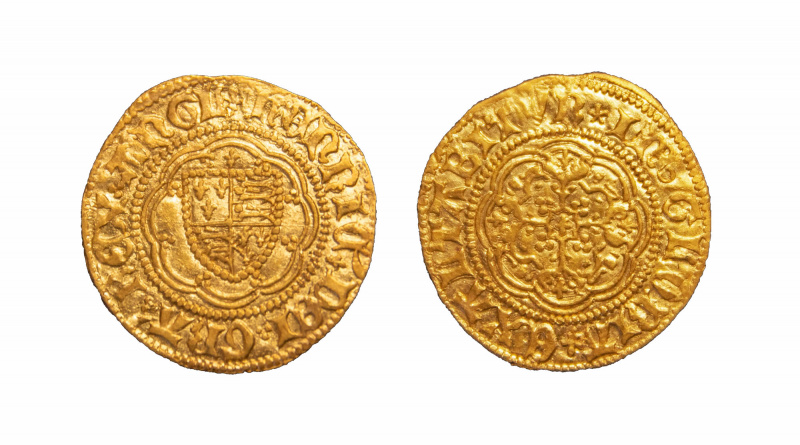Quarter Noble of Henry VI
When this hammered gold coin was unearthed it was rather badly bent. The finder, Alex Graeme, contacted someone skilled in working with gold and it was straightened out successfully. Looking at the illustrations I wouldn’t have thought it had ever been bent, as I can see no sign whatsoever of any remedial work being carried out.
The coin is a quarter noble of Henry VI. On the obverse there is a single fleur de lis over the shield of arms and a legend that reads hEnRIC DEI GRA REX AnGL There is a small fleur de lis after hEnRIC but all the other stops are trefoils.
On the reverse there is a fleur de lis in the centre and the legend on this dies reads EXALTABITVR In GLORLA. There is a cinquefoil before In and an annulet after it. On both sides the mint mark at the start of the legend is a small fleur de lis.
In the Standard Catalogue Henry VI quarter nobles of this type are assigned to Calais and listed as number 1815. They are discussed in more detail by Lord Stewartby in English Coins 1180-1551. Stewartby suggests that this type could be the last one struck under Henry V, rather than the first under Henry VI. Additionally, he assigns the type to London rather than Calais.
Number 1810 in the Standard Catalogue is a ‘standard’ type Henry VI London quarter noble with mint mark large fleur de lis on both sides. The coin found by Alex is number 1815. The catalogue price in Fine condition for 1810 is £300 and for 1815 it is £350. Therefore, it might be assumed that when it comes to scarcity there isn’t much difference between the two types. In actual fact, 1810 is scarce but 1815 is very rare indeed. I traced several of the scarce type but only a single example of the very rare variety.
This quarter noble looks as if it would grade good VF. It is well and centrally struck on a round and unclipped flan; it has good eye appeal and would certainly be of interest to any collector of hammered gold coins.
Valuation
Alex got in touch with me as he wanted a valuation on his find. So what would it be worth? Well, a probable pre-sale auction estimate should be £1,000 – £1,200. The final hammer price would depend on whether or not the rarity of the coin was appreciated. If two specialists got into a bidding battle then it might sell for a figure higher than the upper estimate. However, present-day collectors are more interested in the state of preservation of coins than their rarity, so the eventual outcome is uncertain.
Valuation Service
If you would like your coin identified or valued, please read about my valuation service and contact me

